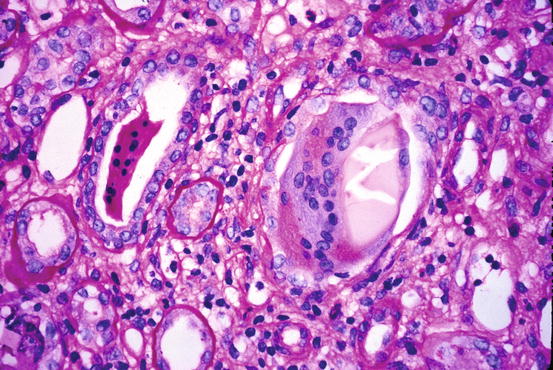, Arthur H. Cohen2, Robert B. Colvin3, J. Charles Jennette4 and Charles E. Alpers5
(1)
Department of Pathology, Microbiology and Immunology, Vanderbilt University Medical Center, Nashville, Tennessee, USA
(2)
Department of Pathology and Laboratory Medicine, Cedars-Sinai Medical Center, Los Angeles, California, USA
(3)
Department of Pathology Harvard Medical School, Massachusetts General Hospital, Boston, Massachusetts, USA
(4)
Department of Pathology and Laboratory Medicine, University of North Carolina, Chapel Hill, North Carolina, USA
(5)
Department of Pathology, University of Washington, Seattle, Washington, USA
Abstract
Renal involvement in multiple myeloma and other plasma cell dyscrasias is largely the result of the effects of the monoclonal protein, usually the light chain, and may be clinically manifested in multiple ways [1–3]. The major lesions include light-chain (Bence Jones or myeloma) cast nephropathy, monoclonal immunoglobulin deposition disease and amyloidosis, usually AL type. The pathologic features of all are distinct and will be discussed in individual chapters. Although each disorder appears to be the consequence of a distinct property of the monoclonal protein, usually the light chain and therefore affected patients theoretically may develop only one of these lesions (one light-chain disease per patient) in practice two or all three may be identified in renal biopsies.
Introduction/Clinical Setting
Renal involvement in multiple myeloma and other plasma cell dyscrasias is largely the result of the effects of the monoclonal protein, usually the light chain, and may be clinically manifested in multiple ways [1–3]. The major lesions include light-chain (Bence Jones or myeloma) cast nephropathy, monoclonal immunoglobulin deposition disease and amyloidosis, usually AL type. The pathologic features of all are distinct and will be discussed in individual chapters. Although each disorder appears to be the consequence of a distinct property of the monoclonal protein, usually the light chain and therefore affected patients theoretically may develop only one of these lesions (one light-chain disease per patient) in practice two or all three may be identified in renal biopsies.
Clinical Presentation
Patients with Bence Jones cast nephropathy usually present with acute kidney injury (less commonly with chronic kidney disease) and Bence Jones proteinuria. It has been known for many years that intravenous radiocontrast media, dehydration, infections, and the use of nonsteroidal antiinflammatory drugs may induce the precipitation of renal tubular light-chain casts and result in acute renal failure, which is reversible in only a small percent of affected patients. A less common manner of presentation is the acquired Fanconi syndrome. This is most often associated with intracellular crystals in plasma cells and tubular cells; the crystals represent the abnormal light chain [2, 4].
Pathologic Findings
Light Microscopy
Light-chain (Bence Jones) cast nephropathy is characterized by prominent casts in renal tubules; the casts are usually large and “brittle,” have fracture lines or are broken into many fragments often with geometric shapes, and are surrounded by tubular epithelium, neutrophils, and typically and diagnostically by multinucleated giant cells of foreign-body type (Fig. 16.1). While they are more common in distal tubules, the casts may be formed in any segment of the nephron, including Bowman’s space. The casts have reasonably typical tinctorial properties: periodic acid-Schiff (PAS) negative, brightly eosinophilic (hematoxylin and eosin), fuchsinophilic with Masson’s trichrome, and, infrequently, Congo red positive. The staining is not always uniform within the same cast or among all casts in the same kidney, but the above colors are most typical. The casts may be lamellated, contain crystals of a variety of shapes, and rarely at the periphery have a spicular appearance, which represents amyloid formation within the cast, not within renal parenchyma. There are reasonably constant abnormalities in tubular epithelium; proximal cells often contain numerous uniform cytoplasmic vacuoles.




